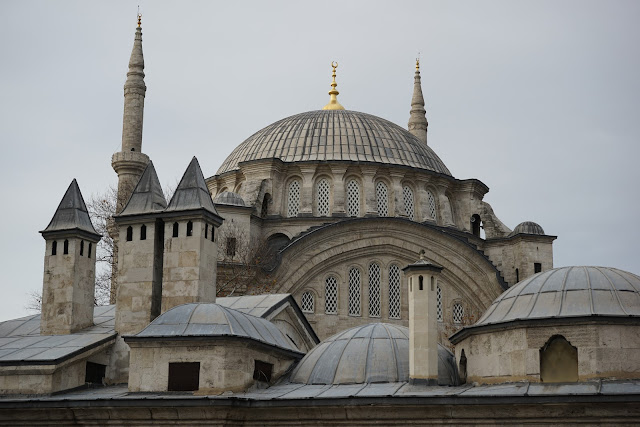As we head into December our year of travels is slowly coming to an end. We have our flights booked back to Canada, have started to think about going back to our desks and looking at MLS listings for a new home. For the last eight months we have been in Asia and it's time to start heading back to the West! So as we travel from India to Canada we stopped in Turkey for a few weeks. We landed at the Sabiha International airport in Istanbul on the continent of Asia and drove over the Bosphorus bridge that took us to the continent of Europe.
We spent one week in Istanbul and loved every minute of it! It's a wonderful modern city filled with history at every corner. Here's a list of all the different civilizations that Istanbul has seen:
- 13th century BC: First tribes known to have settled here.
- 7th century BC: Greeks.
- 196 AD: Roman Empire at which time it was known as Byzantium. The Emperor Constantine renamed it to Constantinople in 330 AD and was the new capital of the Eastern Roman Empire.
- 1453: The Muslim Conquest by the Ottoman Empire. Constantinople became the capital.
- 1923: The Republic of Turkey was founded and then the capital moved to Ankara.
- 1928: Turkey requested that all International countries use the Turkish names for Turkish cities. Since the Turks had been calling Constantinople Istanbul (meaning "the city") for centuries it naturally became its official name! Here is a song to help you remember this: https://youtu.be/rNUsOaB5V2c
With all this history you can imagine the layers of ancient cities that are below the streets! We've learned a lot about Greek, Roman and Ottoman Empires but have only scratched the surface. We did our best and visited the most iconic and historically significant sites.
Hagia Sofia was first built in 453 as a Greek Orthodox cathedral, then converted to a Catholic Church in 1204, then converted into a mosque in 1453 and then finally a museum in 1935. It is a massive structure with a massive dome in the center which is at an elevation of 56m from the floor and is completely decorated with mosaic tiles on the inside. What a spectacular structure!
 |
| Man selling roasted chestnuts outside of the Hagia Sofia at night. |
 |
| Large slabs of marble for the flooring. |
 |
| Various colourful stones used as wall decorations. |
 |
| Beautiful mosaic scenes fill the building. |
 |
| View from the top balcony. |
Directly across from the Hagia Sofia is the famous Sultan Ahmet Mosque built in 1616. It is known as the "Blue Mosque" because of its predominantly blue ceramic tiles that adorn its inside. It was our first visit to a mosque too!
 |
| The inside of the large dome. |
 |
| The blue tiles. |
Topkapi Palace was built for the Ottoman Empires' Sultans, court and many wives.
 |
| Entrance gate. |
 |
| The chimneys from the palace kitchen cooking fires. |
 |
| All the different types of stone used to decorate the buildings are amazing! |
 |
| Intricately hand painted ceramic tiles cover many of the buildings inside and out. |
 |
| The Sultans' mothers' room |
 |
| The view of the Bosphorus straight with Europe on the left and Asia on the right. |
Suleymaniye mosque built in 1550.
 |
| Door to the inner courtyard. I love the use of different coloured stones! |
 |
| Inside the mosque |
 |
| View of Istanbul. |
Or course we had to visit one of the worlds first malls! The Grand Bazaar was built as a covered market which held up to 3000 shops and spanned 61 streets! The shops now sell a wide range of copper ware, leathers, jewelry and all kinds of touristy souvenirs. There are still signs of its original artwork and architectural details. It must have looked spectacular when it was first opened in 1455.
In any good city part of the Roman Empire you will find aqueducts and some good mechanical engineering. The Romans had built up to 500 cisterns to hold water for the citizens of Constantinople.
 |
| Aqueduct. |
 |
| Inside the Basilica Cistern. It once held 80 000m3 of water and has 336 marble columns. |
 |
| Base of a column inside the cistern - Medusa protects the cistern from evil. |
Where there are Romans, there are chariot races! Now the old Hippodrome is a large square with a few obelisks that were erected to honour significant events. One of which is the obelisk of Theodosius which was transported from Egypt by Theodosius in the 4th century AD. It is believed that it was "accidentally" broken in transit (to make it easier for transport!) and its bottom portion lost.
And we found a Catholic church: The Church of St. Anthony of Padua.
We stayed in the old part of Istanbul in the neighbour called Sultanahmet, which turned out to be a good base to visit all the sites but to also just wander the small streets around the city.
 |
| Spices and tea for sale at the market. |
 |
| Fish market. |
 |
| Beyoglu across the Golden Horn from Sultanahmet. Where the locals shop! |
 |
| Chestnut vendor. |
 |
| Walking down Irmak Cd in Beyoglu. |
 |
| Street car heading to Taksim Square on Irmak Cd. |
 |
| Fishermen on the Galata Bridge. |
 |
| Galata Bridge. |
Istanbul has definitely made it to the top of my list!





































No comments:
Post a Comment